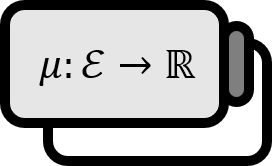Properties of Measurable Functions with Real Values
Theorem1
If two functions defined in a measurable space $(X,\mathcal{E})$ are measurable functions, then the following functions are also measurable:
$$ cf,\quad f^2,\quad f+g,\quad fg,\quad |f| $$
Proof
A function $f : X \to \overline{\mathbb{R}}$ is called a measurable function if it satisfies the following equation for all $\alpha \in \mathbb{R}$:
$$ S_{f}(\alpha):=\left\{ x\in X\ |\ f(x) >\alpha \right\} \in \mathcal{E},\quad \forall \alpha \in \mathbb{R} $$
$cf$
Case 1. $c=0$
$$ \begin{cases} \alpha >0 & \left\{ x \in X\ |\ cf(x)=0 > \alpha \right\} =\emptyset \in \mathcal{E} \\ \alpha \le 0 & \left\{ x \in X\ |\ cf(x)=0 > \alpha \right\}=X \in \mathcal{E} \end{cases} $$
Case 2. $c>0$
$$ \left\{ x \in X\ |\ cf(x) > \alpha \right\}= \left\{ x \in X\ |\ f(x) > \frac{\alpha}{c} \right\} \in \mathcal{E} $$
Case 3. $c <0$
$$ \left\{ x \in X\ |\ cf(x) > \alpha \right\}= \left\{ x \in X\ |\ f(x) < \frac{\alpha}{c} \right\} \in \mathcal{E} $$
■
$f^2$
Case 1. $\alpha < 0$
$$ \left\{ x \in X\ |\ f^2(x) > \alpha \right\}=X \in \mathcal{E} $$
Case 2. $\alpha \ge 0$
$$ \left\{ x \in X\ |\ f^2(x) > \alpha \right\}=\left\{ x \in X\ |\ f(x) > \sqrt{\alpha} \right\} \cup \left\{ x \in X\ |\ f(x) < -\sqrt{\alpha} \right\} \in \mathcal{E} $$
Both sets on the right side are elements of $\mathcal{E}$. Therefore, by the properties of the $\sigma$-algebra, the union of the two sets is also an element of the $\sigma$-algebra.
■
$f+g$
Let’s say $r\in \mathbb{Q}$ and define the following set.
$$ S_{r} :=\left\{ x \in X\ |\ f(x) > r \right\} \cap \left\{ x \in X\ |\ g(x) > \alpha -r \right\} $$
Then, since the two sets on the right are elements of $\mathcal{E}$, their intersection $S_{r}$ is also an element of $\mathcal{E}$ by the definition of the $\sigma$-algebra. Therefore, the countable union of $S_{r}$ is also an element of $\mathcal{E}$. That is, the proof is complete if the following equation is shown.
$$ \left\{ x \in X\ |\ (f+g)(x) > \alpha \right\} = \bigcup_{r\in\mathbb{Q}}S_{r} $$
To simplify, let’s call the equation $\left\{ x \in X\ |\ (f+g)(x) > \alpha \right\}=\left\{ f+g>\alpha \right\}$.
Part 1. $\left\{ x \in X\ |\ (f+g)(x) > \alpha \right\} \supset \bigcup_{r\in\mathbb{Q}}S_{r}$
Since $S_{r}$ is a subset of $\left\{ f+g>\alpha \right\}$ for all $r$, it is obvious that the equation holds.
Part 2. $\left\{ x \in X\ |\ (f+g)(x) > \alpha \right\} \subset \bigcup_{r \in \mathbb{Q} } S_{r}$
Assuming $x \in \left\{ f+g>\alpha \right\}$, we can find a sufficiently small $\epsilon$ that satisfies the following equation.
$$ \begin{equation} f(x) + g(x) > \alpha + \epsilon \end{equation} $$
And let’s choose a rational number $r<f(x)$ so that it becomes $|f(x)-r| < \epsilon$. Then, the following holds.
$$ r < f(x) < r +\epsilon \implies f(x)-\epsilon < r $$
Substituting this into $(1)$ gives the following.
$$ g(x) > \alpha -\big( f(x) -\epsilon \big) > \alpha-r $$
Therefore, for such $r$, since $x \in S_{r}$, for the union of all $r$, $x \in \bigcup_{r\in \mathbb{Q}}S_{r}$ also holds.
By Part 1 and Part 2, the following holds.
$$ \left\{ x \in X\ |\ (f+g)(x) > \alpha \right\} = \bigcup_{r\in\mathbb{Q}}S_{r} $$
■
$fg$
Since $fg=\dfrac{1}{4} \big[ (f+g)^2 - (f-g)^2 \big]$, it holds by the three results above.
■
$|f|$
Case 1. $\alpha \ge 0$
Since $\left\{ x\in X\ |\ |f(x)| > \alpha \right\}=\left\{x\in X\ |\ f(x)>\alpha \right\} \cup \left\{ f(x)<-\alpha \right\}$ and both sets on the right are elements of $\mathcal{E}$, their intersection is also an element of $\mathcal{E}$.
Case 2. $\alpha < 0$
It is obvious since $\left\{x\in X\ |\ |f(x)| > \alpha \right\}=X \in \mathcal{E}$.
■
Robert G. Bartle, The Elements of Integration and Lebesgue Measure (1995), p9-10 ↩︎
